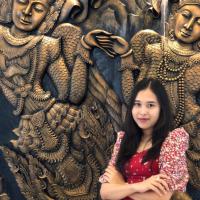- This topic has 12 replies, 13 voices, and was last updated 4 years, 7 months ago by
 Phone Suu Khaing.
Phone Suu Khaing.
-
AuthorPosts
-
-
2021-05-30 at 10:07 am #27569
 SaranathKeymaster
SaranathKeymasterPlease share what you have learned from this week topic with your friends here. This could be infographic picture or text summarization.
For attaching Images purpose. Please UPLOAD to Prnt or any tools you want and mention uploaded LINK in the topic. or use this code <img src=”POST YOUR LINK” alt=”” />
-
2021-05-30 at 10:24 am #27572
 Pongsakorn SadakornParticipant
Pongsakorn SadakornParticipantThis week, I have learned about research integrity and the case study was interesting. I learned about self-plagiarism which is new for me to know that and it hard to distinguished. Moreover, I got an idea for double publication. However, it is dependent on your circumstances and the role of the journal.
On the other hand, Authorship is so important and it would be clarified at the beginning of the research by conducting the discussion with the team. -
2021-05-30 at 1:39 pm #27573
 Rawinan SomaParticipant
Rawinan SomaParticipantHere are my wrap up image.
-
2021-05-30 at 2:21 pm #27574
 Auswin RojanasumapongParticipant
Auswin RojanasumapongParticipantThis week I have learned about integrity in research. While there are main research integrities to be a concern, some of the issues must be carefully considered especially authorship.
From the discussion, my opinion for each question is:
1. Is this called plagiarism?
– It might be called self-plagiarism if the author has an intention to do redundant publication, do “salami-slicing”(make multiple publications derived from a single study) or duplicate publication, but the latter is more acceptable with certain conditions.
2. Is it OK for Dr. A and the team to publish the same results and methodology in another journal (double publication)? Why?
– It is OK, but with certain conditions. Dr. A and the team must declare that this is a double publication to both journals and ask them for permission. The publications must be different in the target group (which in this case, different regions).
3. Are there any situations where double publication is acceptable?
– Intended for a different group of a reader, newer methods and give newer perspective
4. In your opinion, what is/are the main characteristics/roles of the first author and/or corresponding author?
– The main contributor of the research, take the most responsible and take responsibility for communication with the journal. -
2021-05-30 at 2:43 pm #27575
 Saravalee SuphakarnParticipant
Saravalee SuphakarnParticipantMy wrap-up assignment, please follow this link http://prnt.sc/13kztp4
-
2021-05-30 at 5:26 pm #27576
 NaphatParticipant
NaphatParticipantI have learnt about research integrity especially in plagiarism, self-plagiarism and double publication as discuss on webinar. These courses are a new thing for me. Because I have no experiences about research too much and no any publications. I have some wrap-up as follow;
1.Is this called plagiarism?
In my opinion. This is not plagiarism, because this is Dr.A and team’s work. But self-plagiarism is the good topic to discuss about this situation because sometimes we are not follow the theory or rule of research.2.Is it OK for Dr. A and team to publish the same results and methodology in another journal (double publication)? Why?
Yes, this is ok for Dr.A and team to double publication because different language and reader groups but Dr.A and team must to declare about this to Editors of both journals.3.Are there any situations where double publication is acceptable?
– Editors of both journals know and accept the double publication
– Publication interval at least 1 week
– Clearly indicate the secondary publication
– Intended for a different group of readers and different language
– Reflect the data and interpretation of the primary version
– Provide footnote on the title page indicated the secondary version
– Permission for such secondary publication should be free of charge
– When there are new methods to analyse and give newer perspective
– New knowledge with high impact to global
– Clearly indicate the secondary publication4.In your opinion, what is/are the main characteristics/roles of first author and/or corresponding author?
The First author is the person whose is the first name in the research. Responsible for conducting research and write that manuscript by yourself.
Corresponding author is the person who responsible of review the original thesis. Provide advice and coordinate with all parts of the original research article submission for publication. This includes any correspondence related to this work that may occur in the future. Corresponding Author is usually not a student, but will be a teacher or advisor, research director, program director etc.
This does not mean Corresponding Author is more important than First Author because it performs different functions.And the topic in “Who’s could be the authors in publication” is the great topic to discuss the most. Because now a day we just follow the cultural but not follow the theory of research. And I think the limitation no. of authors in publication is great for help researcher to decide.
-
2021-05-30 at 8:01 pm #27577
 Navinee KruahongParticipant
Navinee KruahongParticipantHere is my summary! https://ibb.co/N7BsdF1
-
2021-05-31 at 1:17 am #27581
 Wachirawit SupasaParticipant
Wachirawit SupasaParticipant
-
2021-05-31 at 3:17 am #27582
 Khaing Zin Zin HtweParticipant
Khaing Zin Zin HtweParticipantPlease check my wrap-up.
-
2021-05-31 at 11:05 am #27584
 Sittidech SurasriParticipant
Sittidech SurasriParticipantPlease see my wrap-up assignment as link: https://prnt.sc/13m7mbj
Responsible Conduct of Research
– Research Ethics
o Research behavior viewed from the perspective of moral principle– Research Integrity
o Research behavior viewed from the perspective of professional standards
o Means conducting research in such a way that allows others to have confidence and trust in the methods and the findings of the research. It relates both to the scientific integrity of conducted research and to the professional integrity of researchers
o Research misconduct
Data Falsification
• Correct the data/ Publish false data
Data Fabrication
• Makeup the data that have not been done
Plagiarism
• Copying somebody’s work and presenting it as your own
Altering result in the knowledge of allocation
Example of types of misconduct:
• Over-interpretation of significant finding in small trials
• Selective reporting based on p-values
• Selective reporting of outcomes in the abstract
– Double publication: acceptance criteria
o Intended for a different group of readers
o Editors of both journals know and accept the double publication
o Clearly indicate the secondary publication
o Publication interval at least 1 week
o Reflect the data and interpretation of the primary version
o Provide footnote on the title page indicated the secondary version
o Permission for such secondary publication should be free of charge
– Authorship Rule
o Substantial contributions to the conception or design of the work; or the acquisition, analysis, or interpretation of data for the work; AND
o Drafting the work or revising it critically for important intellectual content; AND
o Final approval of the version to be published; AND
o Agreement to be accountable for all aspects of the work in ensuring that questions related to the accuracy or integrity of any part of the work are appropriately investigated and resolved
– Topic discussion:
– We were discussed about case study that Dr. A and his team published the paper in an Epidemiology journal of Thailand (in Thai language). Many people said that they should have submitted the manuscript to an international journal, as these results would be of interest to people in other countries.
– Dr. A and team then translated this published manuscript into English and submitted the manuscript to another international journal.
– Is this called plagiarism? “No” but thinking about self/ auto-plagiarism
– Is it okay for Dr.A and team to publish the same results and methodology in another journal (double publication) why? “yes” and “No”. Both editors from 1st and 2nd journals must be accepted.
– Are there any situations where double publication is acceptable? see above “Double publication: acceptance criteria”
– In your opinion, what is/are the main characteristics/ roles of first author and/or corresponding author? “who takes primary responsibility for communication with the journal during the manuscript submission, peer review, and publication process, and typically ensures that all the journal’s administrative requirements, such as providing details of authorship, ethics committee approval, clinical trial registration documentation, and gathering conflict of interest forms and statements, are properly completed, although these duties may be delegated to one or more coauthors”
– Examples of authorships -
2021-05-31 at 11:57 am #27589
 Kaung Khant TinParticipant
Kaung Khant TinParticipantHere’s my wrap-up. Please follow the link. https://prnt.sc/13m9y7u
-
2021-06-04 at 4:02 pm #27647
 Kridsada SirichaisitParticipant
Kridsada SirichaisitParticipantMy wrap-up https://prnt.sc/13zjn9b
-
2021-06-05 at 5:09 pm #27657
 Phone Suu KhaingParticipant
Phone Suu KhaingParticipantPlease find my wrap up here https://prnt.sc/146bqos
-
-
AuthorPosts
You must be logged in to reply to this topic. Login here
